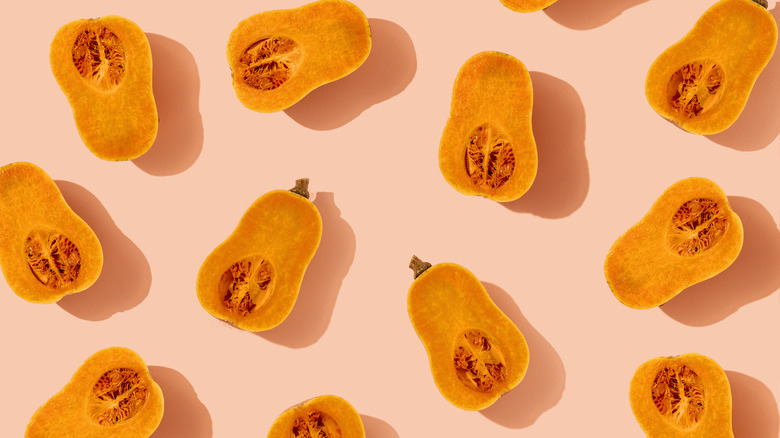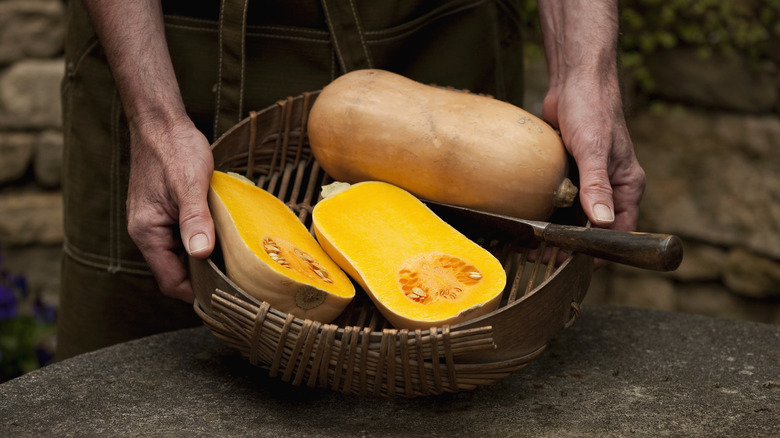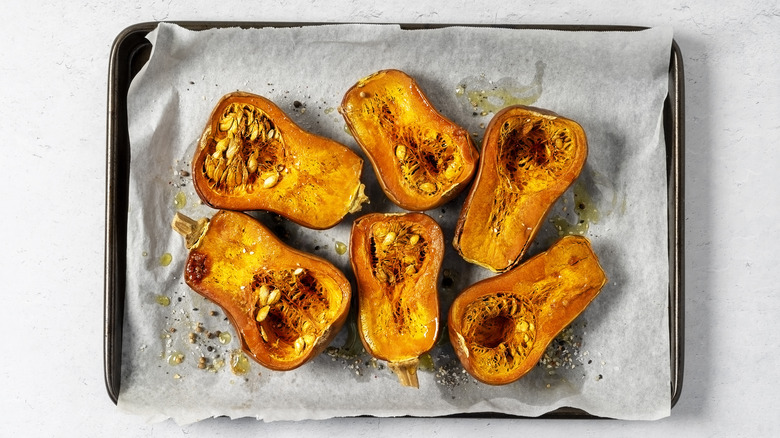The Best Place To Store Butternut Squash So It Lasts Longer
A squash can last for longer than you'd expect most fresh fruits or vegetables to. This is more so the case with winter varieties like butternut squash, for instance. These have thick, hard rinds that work as protective armor to keep the flesh inside smooth, dry, and firm for months. When left whole, fresh butternut squash will last for anywhere between one to three months – whether it is kept in the refrigerator or at room temperature. And that's not even the best part: It can last for much longer than that when stored in a freezer.
In fact, a freezer can help butternut squash stay fresh for as long as a year, and there are two main ways to go about it. One option is to peel the squash and dice it into small cubes (and the absolute quickest way to cut butternut squash is to cook it first). Next, lay the cubes in a single layer on a tray and flash-freeze them. Transfer the chopped squash into an airtight container after a few hours, and then pop that back into the freezer until you're ready to get cooking.
Alternatively, you can puree the squash and freeze it into ice cubes. Both methods can preserve a butternut squash and make it last for longer, so it really depends on what's more convenient. However, make sure that you take the necessary steps to prevent squash hands before prepping the fruit — it's a real thing.
Make sure that your butternut squash is cured
Most store-bought butternut squashes are already cured before they are sold. However, it's best to double-check if you happen to buy one from a farmer's market. You'll even want to cure it yourself if you've grown the winter fruit in your own garden, as this step is crucial in determining how long your butternut will last.
The hard rinds of most winter squashes are still soft after harvest, meaning they don't have a very long shelf life at this stage. Once plucked off their vines, these squashes are left out in warm temperatures to cure — a process that dries the fruit and gets rid of its surplus water content, as well as thickens its skin. As this rind toughens, it also slows down the rate at which the squash respires, which, in turn, helps it stay fresh for longer and makes it more resistant to rot.
To check whether your butternut squash is cured or not, gently press your fingernail into it. Cured squashes have sturdy rinds that don't bruise easily, so if your nail creates a dent or cuts through the skin, you'll need to go home and cure the fruit. To do so, simply lay the butternut squash under the sun in a dry and flat area. Let it dry for one to two weeks, and make sure to rotate it frequently so that all sides of the squash cure thoroughly.
How to buy a fresh butternut squash so it lasts longer
Freezing can only do so much if the butternut squash is already on its way to spoilage when you buy it, so always look out for certain signs to determine its freshness. The most obvious indicator is its rind: A perfectly ripe butternut squash will have a deep and uniform beige tint, so stay away from those that have green patches of discoloration on them.
Another thing to see is whether the squash has a stem on it or not. Stemless ones spoil faster, so it's best to cook them quickly and turn them into creamy butternut squash and sage risotto instead of freezing. Most importantly, steer clear of squashes that have cuts or brown spots on them — these are indicators of a squash that's not going to stay fresh for long no matter how well it is stored.
It's also a good idea to pick up the winter squash and feel it under your fingers. A ripe butternut will feel firm and won't have any soft or mushy spots. Avoid buying specimens that feel hollow, or whose even-colored, matte skins feel shriveled or leathery to the touch. These are signs that the squash is old and spoiled. Don't be afraid to give it a good whiff too. A ripe butternut will have a delicate, earthy fragrance, and anything that smells sour or unpleasant is a sign that the winter squash is already spoiled.



